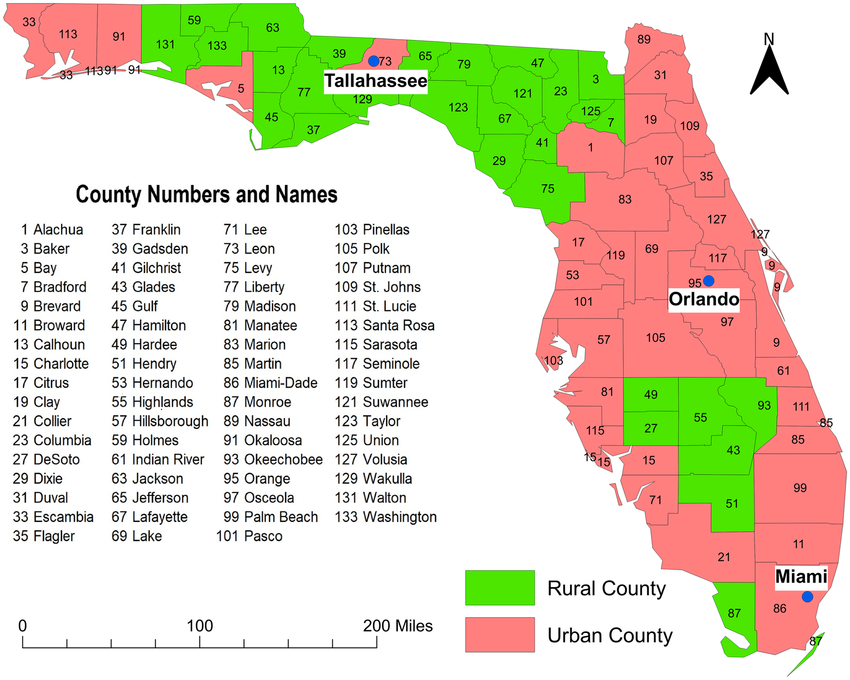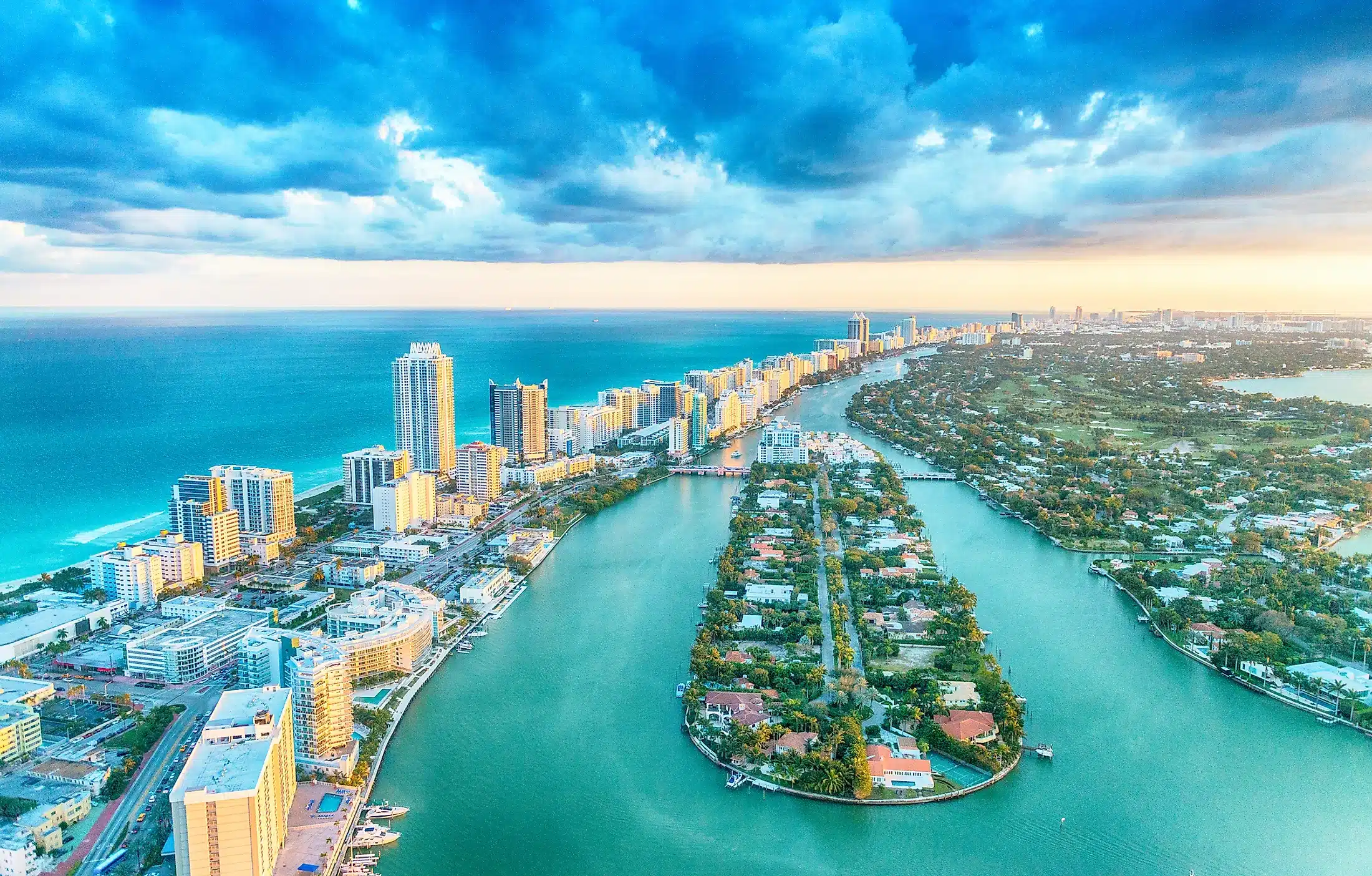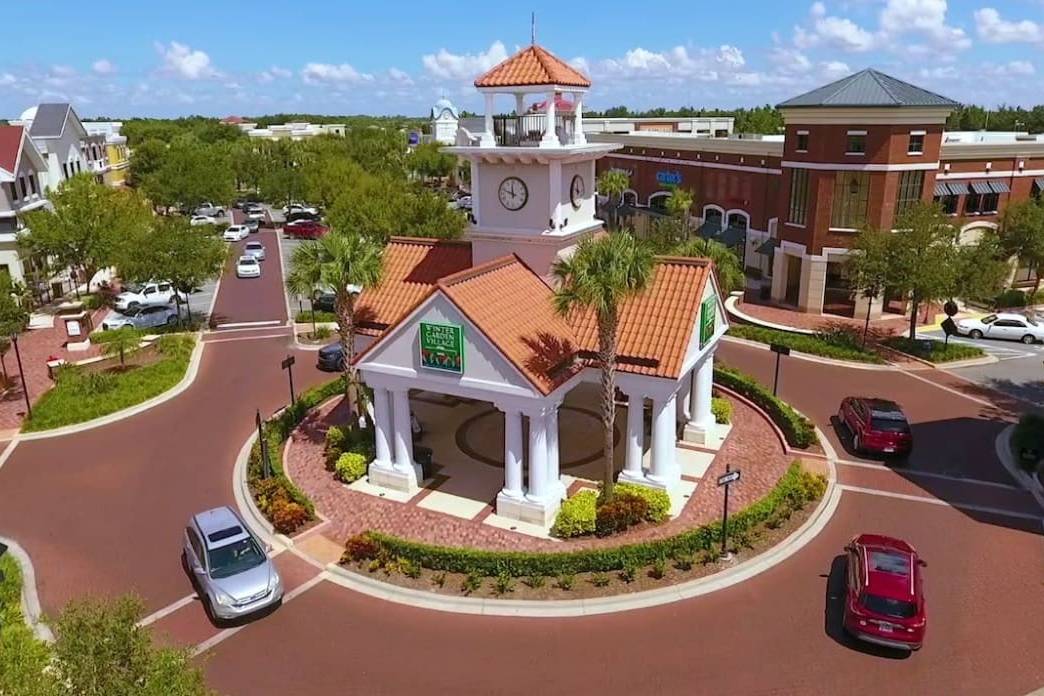When planning a move, an investment or even a longer trip, understanding how the territorial division of a state works is essential, and in Florida this is no different. Many people hear about "county", "city", "metropolitan area" or "unincorporated area"But few actually know what these classifications mean or how they impact on practical day-to-day decisions.
In the case of Florida, these divisions go far beyond names on the map. They directly affect taxes, real estate licensing, the quality of public services, schools, zoning rules and even the possibility of renting a vacation property. That's why knowing the structure of Florida counties and understanding how they relate to cities and regions is fundamental for those who wish to live, undertake or invest safely in the state.
In this article, we're going to simplify this topic and clearly show you the difference between Florida's counties, the cities that are part of them and other administrative divisions that can influence your choices.
County - numbers and names

Map of Florida showing the geographical distribution of urban and rural counties. The figure was created using the Geographic Information System (GIS) software QGIS
Contents
HideIn the United States counties (countiesare administrative divisions that function as a kind of state "sub-government". They are positioned between the state government and the cities, and their main function is to manage essential public services on a regionalized basis. Each American state has the autonomy to define how many counties it will have and what its internal administrative structure will look like.
In the American context, counties are not just territorial divisions on the map: they play an active role in the lives of the population, controlling areas such as public education, health, safety, transportation, licensing, local tax collection and urban planning. Counties have their own governing bodies, which include commissions, departments and, in many cases, even independent police forces, the famous Sheriff's Office.
How many counties are there in Florida?
Florida has 67 countiesEach has its own characteristics in terms of population, economy, culture, infrastructure and local legislation. This variety makes it all the more important to understand how Florida countiesbecause the rules can change from one to another, even when you're in the same metropolitan area.
Some counties are highly urban and densely populated, such as Miami-Dadewhile others, such as Gilchrist CountyIn addition, some of the cities have a rural population and much simpler infrastructure. This diversity affects everything from tax rates to restrictions on short-term rentals, which is particularly relevant for real estate investors or those wishing to start a local business.
Examples of important counties in Florida
-
Miami-Dade CountyIt is the most populous county in Florida and is home to world-famous cities such as Miami and Miami Beach. It is the state's financial, tourist and cultural center.
-
Orange County: One of the most sought after by those wishing to invest or live in the Orlando area. This is where the world's most famous theme parks are located, such as Walt Disney World and Universal Studios, as well as the city of Orlando itself, which is the county seat.
-
Broward CountyLocated north of Miami-Dade, it includes cities such as Fort Lauderdale and Hollywood (Florida). It is a coastal region with a strong tourist appeal and a dynamic economy.
-
Hillsborough CountyTampa is a port city of great logistical and industrial importance. It is one of the fastest growing regions in Central Florida.
-
Palm Beach County: Known for its beaches, golf courses and for being one of the regions with the highest concentration of wealth among residents. It is home to cities such as Boca Raton and West Palm Beach.
Administrative functions of counties
Florida's counties are responsible for a number of services that directly impact the lives of residents and business owners. Among the main ones are:
-
Public education: Florida's public schools are administered by school districts that follow county boundaries. This means that the quality of education varies from county to county.
-
Public safety: Most counties have their own sheriff's department (Sheriff's Office), responsible for policing in unincorporated areas and running local prisons.
-
Urban planning and zoning: Each county has specific rules on land use, which have a direct impact on those who want to build, renovate or rent property. Investors need to pay close attention to these rules.
-
Taxes and licensing: Counties issue business licenses, building permits and collect sales, property and tourism taxes. Each may have different rates, exemptions or documentation requirements.
Understanding these attributions is fundamental for those looking to make better decisions about where to invest, undertake or live. After all, Florida's counties are not all the same - and understanding these differences can mean savings, faster processes and a greater return on investment.
What is a City
In the administrative structure of the United States, and specifically within the counties of Florida, the term city refers to a incorporated city, with local government establishedusually including a mayor (mayor) and a city council. These cities have the authority to create local laws, collect taxes, offer public services (such as garbage collection, local policing and street lighting) and issue their own licenses. Most of Florida's large urban areas, such as Miami, Orlando and Tampa, are classified as cities.
What is a Town
Towns are also incorporated communities within a countyHowever, they are usually smaller in population and territorial extension than the cities. Although they have a similar local government structure, the towns generally offer a more limited number of services directly and may depend more on the county administration for certain public services. In many cases, the distinction between city e town is only nominal, determined by the locality's charter of incorporation.
What is a Municipality
Municipality is the generic term used to refer to any incorporated entity with its own government, be it a city, town or village. It appears frequently in official documents, legislation and public forms. In other words, all cities e towns are considered municipalitiesThis only reinforces the fact that they have a certain autonomy from the government of the county in which they are located.
Relationship between counties and cities
Each city or municipality is within a single county and cannot cover areas in two counties at the same time. This means that all cities are part of one of Florida's 67 counties, respecting their geographical boundaries. The county continues to have responsibility for areas outside the cities, known as unincorporated areas (unincorporated areas), but also works in partnership with municipalities on various services.
While counties take care of the administration of their entire territory, including unincorporated areas, cities have their own management structure for local issues. It is common, for example, for a city to establish its own rules on construction, short-term rentals or local taxation - even though it is subordinate to the county on broader issues such as justice and public health.
Practical example: Orlando and Orange County
One of the most emblematic examples of this structure is the city of Orlandowhich is located inside the Orange County. Orlando is a city with its own municipal government, which manages issues such as urban policing, public transportation, road maintenance and commercial inspection. Its residents pay municipal taxes in addition to the taxes levied by the county.
The rest of Orange County is made up of other cities (such as Winter Garden, Windermere, Ocoee and Apopka) and unincorporated areas, where the county government acts directly. A curious fact is that the famous Disney parks are not in the city of Orlando, as many people think, but in Lake Buena VistaOrange County is a small incorporated city within Orange County. This confusion reinforces the importance of understanding the difference between city and county when dealing with real estate, business or even tourism in the region.
What they are
The unincorporated areas, called in English unincorporated areas, are regions within Florida's counties that do not belong to any city or municipality. This means that these areas do not have their own municipal government, such as a mayor or city council. Instead, are administered directly by the county governmentwhich assumes responsibility for all public services and the application of local rules.
These areas can range from rural areas and residential neighborhoods to highly developed planned communities. The absence of a municipal structure, however, does not mean a lack of organization, only that management is centralized in the county.
How they work
In unincorporated areas, the county is responsible for everythingThese include policing, garbage collection, public services, building permits and even zoning regulations. Therefore, the rules and level of service vary according to the capacity and decisions of each county. Many of these regions have local advisory councils (advisory boards), but the final authority always lies with the county government.
It is worth remembering that as these areas are not cities, they do not have municipal representation. All administrative matters are dealt with by the county, and the provision of services can be more standardized, which can be advantageous in some cases and limiting in others, depending on the needs of the resident or investor.
Differences in public services and taxes
In general, those who live or own property in an unincorporated area pays less local taxesas there are no additional municipal charges. However, this can also mean less access to certain servicesThese include dedicated policing, frequent maintenance of local roads or community programs that are more common in incorporated cities.
In addition, building, rental and zoning rules can be different, and often more flexible, in unincorporated areas. This can attract investors and entrepreneurs looking for less red tape, as long as they are aware of the requirements of the corresponding county.
Example: popular areas near Orlando that are not cities
In the central region of Florida, especially around Orlando, there are several well-known communities that are not incorporated cities, i.e. they are administered by the Orange County. A famous example is Dr. Phillips, a high-end residential area that attracts many families and investors, but which it's not a city. Another example is Horizon West, a region in full expansion with new schools, shopping centers and high potential for appreciation, also located in a unincorporated area.
Many people who buy property in these areas believe they are living in Orlando, but in fact they are in areas under the direct management of the county. This influences everything from tax rates to property use permits, especially in the case of short-term rentals such as Airbnb. Therefore, knowing the difference between an incorporated city and an unincorporated area is essential to avoid surprises.
Dr. Phillips

Popular cities and their respective counties
Florida is a diverse state, with world-famous cities belonging to different Florida counties. Knowing this association is fundamental to understanding who administers the region, what rules apply and what taxes will be levied. Here are some examples:
-
Miami - Miami-Dade County
-
Orlando - Orange County
-
Tampa - Hillsborough County
-
Fort Lauderdale - Broward County
-
West Palm Beach - Palm Beach County
-
Kissimmee - Osceola County
-
Naples - Collier County
-
Sarasota - Sarasota County
-
Jacksonville - Duval County (where city and county are unified)
-
St. Augustine - St. Johns County
In addition to these, there are many smaller or suburban cities with great economic and real estate relevance, such as Winter Garden, Coral Gables, Windermere, Boca Raton and Clearwatereach with its own county and set of rules.
Curiosities about governance, taxes, schools and zoning
Each city in Florida follows the guidelines of the county in which it is located, but also has the autonomy to create its own laws and taxes. This results in significant differences in property tax, quality of public schools, urban services and land use rules.
For example:
-
Miami and other cities in Miami-Dade County have specific legislation for vacation rentals, with strong enforcement and restrictions on residential areas.
-
Orlando has an active government on transportation issues and encourages mixed residential and commercial zones, which can favor investments in multifunctional real estate.
-
In Windermere and other smaller cities, zoning rules are stricter, preserving the residential profile and restricting certain types of construction or business.
-
O school system also varies according to the county - which directly influences the value of real estate in certain regions.
In some cases, the county government is responsible for schools (as is the case in Orange County Public Schools, one of Florida's largest school districts), while cities take care of more localized issues, such as parks and community services.
Why it matters for those buying a house or investing
Knowing in which city and county the property is located goes far beyond geography: directly impacts costs and opportunities. Two properties with similar characteristics, just a few minutes from each other, can be subject to completely different rules and fees.
For those looking to invest in short-term rentals, for example, it is essential to check whether the Florida county allows this type of activity in the desired city, and whether a specific license is required. Those looking to live and raise children, on the other hand, should consider the local school district, which is defined by the county.
In addition, property tax rates (property tax) vary considerably from one county to another, and this can significantly affect the annual cost of the investment. Understanding this structure avoids legal and financial surprises, and allows the buyer or investor to make decisions in line with their objectives.
Miami

What are metropolitan areas (MSAs)?
The metropolitan regionscalled in the United States Metropolitan Statistical Areas (MSAs), are urban groupings defined by the federal government, more specifically by the U.S. Census Bureau, based on criteria such as population density, economic interdependence and the flow of work between municipalities. They are not political or administrative divisions, like Florida's counties, but functional regions that help to understand how cities organize and connect.
Each MSA is made up of a main city and several other cities and communities around it, usually located in one or more adjacent counties. These areas share infrastructure, labor, commerce and services, functioning as a cohesive economic and social unit.
Example: Orlando-Kissimmee-Sanford MSA
An emblematic example in Florida is the Orlando metropolitan areaofficially called Orlando-Kissimmee-Sanford MSA. It encompasses not only the city of Orlando, but also several other nearby cities and communities located in different Florida counties:
-
Orange County (where the city of Orlando is)
-
Osceola County (where Kissimmee is)
-
Seminole County (where Sanford is)
-
In some expanded classifications, it also includes parts of Lake County
This metropolitan area is one of the fastest growing in the United States, driven by tourism, technology, logistics and the real estate market. Many people who say they live in "Orlando" actually live in neighboring cities such as Kissimmee, Winter Garden or Altamonte Springs, all technically within the MSA, but with their own administrations and located in different counties.
Difference between "Orlando city" and "Orlando metropolitan area"
A Orlando city is a city incorporated, with its own government, located within the Orange County. The Orlando metropolitan area includes several surrounding towns and communities, each belonging to one of the Florida counties that make up the MSA.
This difference is fundamental for anyone looking to invest, buy real estate or understand regional statistics. For example:
-
Real estate prices, tax rates and regulations vary between Orlando, Kissimmee and Sanford, even though they are in the same metropolitan area.
-
Vacation rentals may be allowed in Kissimmee (in Osceola County), but restricted in Orlando (in Orange County).
-
Indicators of growth, average income and urban development presented for "Orlando" in reports or surveys often refer to the MSA as a whole, not just the city.
Therefore, when planning a move, investment or market analysis, it is important to differentiate between the central city of metropolitan regionand see which of Florida's counties the place of interest is located in.
Downtown Orlando

What they are
In addition to the traditional divisions such as cities e Florida countiesThere are complementary administrative structures called special districts (special districts) e regulatory zones (zones), created to serve specific functions within a given area. These districts are established by state, county or municipal authorities to manage public services, develop projects or regulate economic activities.
Some common examples include:
-
School districtsThe Orange County Public Schools, which is responsible for the administration of public schools within the county.
-
Special tax zones (tax increment zones or community redevelopment areas), created to stimulate urban or commercial development in specific regions.
-
Public service districtsthat take care of sewage, drainage, water supply or security.
-
Reedy Creek Improvement District (RCID)This district, perhaps the most famous example in Florida, was created in the 1960s so that the Walt Disney Company could manage its own infrastructure in the area where the parks are located. In 2023, this district was restructured and renamed to Central Florida Tourism Oversight DistrictBut it still operates as an independent entity.
How they affect residents and investors
The special districts e areas directly impact the lives of residents and investors through specific rules, differentiated taxation, exclusive services or additional obligations. A property located within a tax incentive zone, for example, may benefit from tax exemptions, while another in a special drainage district may have extra charges for infrastructure maintenance.
For those who invest in real estate, understanding whether the property falls within any special districts is crucial. This can mean additional fees on the annual tax bill (e.g: non-ad valorem assessments), restrictions on the type of construction allowed, or, on the contrary, opportunities for public funding and incentives.
In addition, school districts with a good reputation raise the value of residential properties and attract families, making these areas more valuable and competitive.
Different responsibilities for cities and counties
Cities and counties in Florida are responsible for the general administration of their territories, but the special districts operate in parallelThey have well-defined attributions. A county can, for example, delegate the management of a technology park to a special district, while the city takes care of public safety and business licensing in the same area.
This overlap may confuse those unfamiliar with the local structure, but it is important to understand that each entity has authority over a specific aspect of public or private management. More attentive investors use this information to choose regions with a better cost-benefit ratio, a lower tax burden or greater freedom of use.
Difference in taxes and duties
One of the most important factors when choosing where to live or invest in Florida is the impact direct financial that geographic decisions generate. Each of Florida's counties defines its own property tax ratesIn addition to being able to apply additional fees for services such as garbage collection, security and public maintenance.
In addition, some cities also apply their own taxes, which means that a property may be subject to both county and municipal charges. In unincorporated areas, where there is no city, only the county tax applies, which can result in lower annual costsbut also less personalized urban services.
Choice of schools
A quality of public schools is defined from the school districts, which follow the limits of the Florida counties. This means that when you buy a property, the address will automatically determine which school network your children will be enrolled in.
Counties like Orange, Seminole and St. Johns, for example, have well-rated school systems, which significantly increase the value of real estate in these areas. Many buyers choose a county based on its school ranking, even if the city itself is not as well known. For long-term investors, real estate in good school districts tends to have greater appreciation and demand for family rentals.
Zoning rules
O zoning is the set of rules that defines what can be built, remodeled or operated in a given area - residential, commercial, mixed, agricultural, etc. Both cities and counties in Florida have the authority to establish their own zoning guidelines.
This means that, when buying land or property, it is essential to check that it is in an incorporated city or unincorporated areaThe rules can change completely. Tourist cities like Orlando or Miami have very specific residential zones, where certain types of commercial use, such as vacation rentals or retail, are prohibited.
Short-term licensing (Airbnb) by city and county
The short-term rentalsIn many cases, real estate, such as Airbnb, is one of the most affected by the differences between cities and counties in Florida. In many cases, a property may be in a county that allows Airbnb, but located in a city that does not. prohibits or severely restricts vacation rentals.
For example:
-
In Kissimmee (Osceola County), short-term rentals are widely permitted in several zones.
-
In Orlando (Orange County), there are specific rulesThere is also a requirement for a license and residential areas where the practice is prohibited.
-
In unincorporated areas of Osceola or Polk CountyThere is more flexibility, which attracts Airbnb investors.
It is therefore essential to check not only the county, but also also the municipality and the exact zoning of the property before purchasing a vacation rental. Small variations in address can result in significant differences in regulation, and ignoring this could lead to losses or legal sanctions.
Storey Lake Resort - Kissimmee

Understanding the structure of Florida's counties, their cities and special zones is essential to avoid rash decisions, whether you're buying property, investing, starting a business or simply planning a move to the state. As we've seen throughout this article, the differences between an incorporated city, an unincorporated area and a special district can have a direct impact on taxes, legal permits, real estate valuation and quality of life.
Practical tips for those just starting out:
-
Always check in which county and city the property is located, especially in metropolitan areas where the boundaries are blurred.
-
See local zoning before investing in commercial or vacation rental properties.
-
Analyze the specific taxes and fees applicable to that region, which can vary significantly between Florida counties.
-
Evaluate the school district associated with the address, even for investors, this factor influences the value of the property.
-
Use official maps, town hall websites and reliable platforms to confirm this information.
Where to find reliable information
When researching, avoid relying solely on real estate websites or forums. The safest way to navigate between Florida's counties is with the support of official sources and those who really understand the subject. The The Florida Lounge offers educational content, market updates and an experienced team ready to help those wishing to buy, invest or migrate to Florida in a safe and strategic way.
Talk to an expert
If you are still in doubt about which city or region is ideal for your goal, or if you want to better understand the legal and financial implications of your project, talk to a specialist at The Florida Lounge. Our team is available to assist you by WhatsApp and clarify all the details with the transparency and experience of someone who lives the Florida market every day.
Sources used and recommended:
-
Florida Association of Counties (FAC)
Official information about Florida's 67 counties, administrative functions and government structure. -
U.S. Census Bureau - Metropolitan Statistical Areas (MSAs)
Official basis for defining US metropolitan regions. -
Orange County Government
Official website of Orange County, with zoning rules, schools, taxes and licensing. -
Osceola County Government
Local rules for short-term rentals, zoning and urban development. -
Florida Department of Revenue
Information on state and local taxes, including property taxes. -
Reedy Creek Improvement District (now Central Florida Tourism Oversight District)
History and structure of the special district that manages the Disney area. -
GreatSchools - Evaluation of public schools by school district
Useful tool for checking the quality of schools in each county. -
The Florida Lounge
Consultancy specializing in real estate, investments and immigration in Florida, with up-to-date educational content.
Thalita Felisardo
Born on VHS, a Super Nintendo warrior and a lifelong theme park addict. Broadcaster, publicist and Orlando explorer by passion! I used to be Mickey's neighbor and I've made over 100 visits to Disney and Universal parks 🎢. Today I've swapped the enchanted castles for the rocky mountains of Canada, but my heart is still divided between the Northern Lights and the Magic Kingdom fireworks.
Related Posts
September 25, 2025
Panorama atualizado do aluguel em Orlando em 2025
Construction cranes aren't the only things going up amid Orlando's boom. This…





